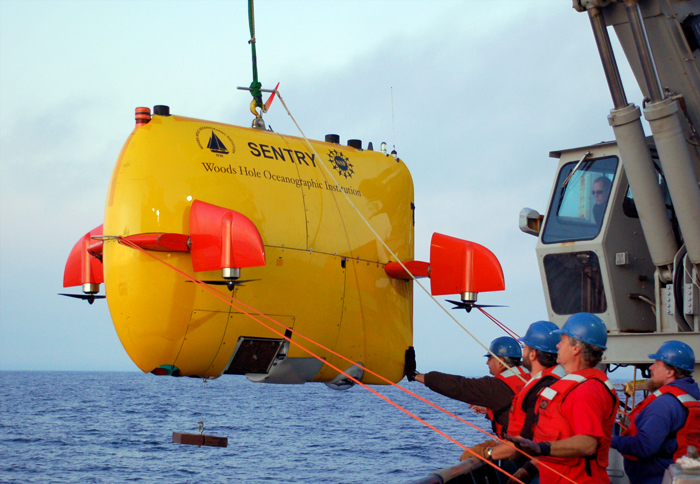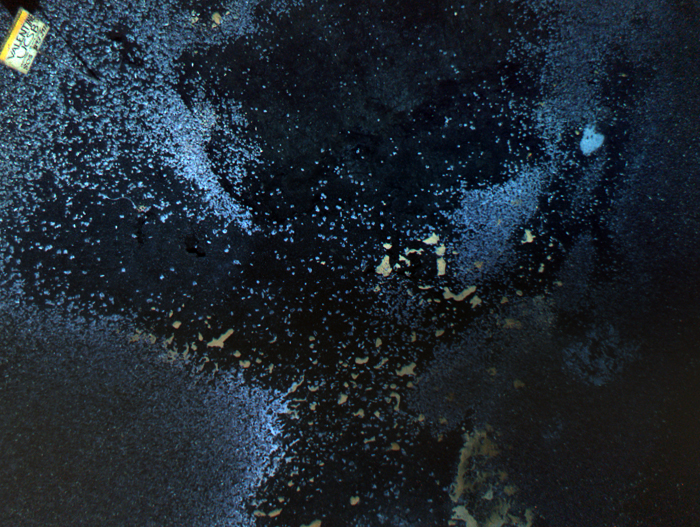WHOI's new deep-diving autonomous underwater vehicle Sentry was launched from the WHOI research vessel Atlantis off the coast of Santa Barbara, Calif., to search for cold seeps—naturally occurring oil, gas, and other hydrocarbons that are leaking from the seafloor. Scientists are developing ways to give the robot abilities to interpret data on the fly and change operations to accomplish missions more effectively without human intervention. (Chris Reddy, Woods Hole Oceanographic Institution)
Before a dive, WHOI engineer Rod Catanach prepares Sentry's high-tech “nose”—an underwater mass spectrometer developed by WHOI scientist Rich Camilli that can detect and identify minute quantities of chemicals in seawater. The instrument, called TETHYS, is in the cylindrical gray metal housing with the multiple rows of band clamps around it. (Rich Camilli, Woods Hole Oceanographic Institution)
|
WHOI scientists Rich Camilli (left) and Dana Yoerger have spearheaded efforts to give more autonomy to the autonomous underwater vehicleSentry. Yoerger helped lead the development of the deep-sea robot. Camilli engineered the TETHYS underwater mass spectrometer that allows Sentryto collect chemical clues in the ocean. (Chris Reddy, Woods Hole Oceanographic Institution)
Enlarge ImageMarine geochemists Dave Valentine (left) of the University of California, Santa Barbara, and Chris Reddy of WHOI study natural oil seeps on the seafloor right off the coast of Santa Barbara. Above, they sniff a rock sample recovered from the ocean bottom that still retained its petrochemical odor. (Karin Lemkau, Woods Hole Oceanographic Institution)
It’s a lot easier to send a bloodhound to track a criminal, or your kid to pick up groceries, than it is to get a deep-sea robot to find something on the seafloor.
The dog will pick up the scent and know to turn around if the bad guy doubles back. The kid can use his eyes and brain to wend his way to the vegetable aisle and recognize a red pepper. But deep-sea robots are typically dispatched on programmed missions, swimming up and back along designated track lines, like a mower cutting a lawn, and blindly collecting data. Only after the vehicle resurfaces can scientists download the data to see what the robots may have found.
These autonomous underwater vehicles, or AUVS, move autonomously in that they swim unmanned and unconnected to a ship via a tether. But they have lacked that essential capability to think autonomously—to interpret cues they gather from the environment, make decisions on the fly, and change course as necessary to accomplish missions more effectively and efficiently.
Scientists are beginning to experiment with ways to give AUVs more decision-making capabilities, and on a research cruise in September 2009 off Santa Barbara, Calif., scientists from Woods Hole Oceanographic Institution (WHOI) demonstrated that they could teach a new robot some old tricks.
They equipped an AUV called Sentry with a high-tech “nose”—an underwater mass spectrometer developed by WHOI scientist Rich Camilli that can detect and identify minute quantities of chemicals in seawater. Then they gave Sentry some brains, in the form of software to analyze the chemicals it was sniffing—in this case, naturally occurring oil, gas, and other hydrocarbons leaking from the seafloor in areas known as “cold seeps.” Finally, they gave Sentry the ability to change its pre-programmed course and operating mode, so it could home in on targets and begin sampling right away, instead of waiting to return on a subsequent mission.
In engineers’ parlance, it’s called “dynamic re-tasking to execute non-deterministic missions.” In other words, Sentry took its first baby steps on the road toward making its own decisions without input from people.
'Extraterrestrial' environments
That’s precisely the capability NASA needs in vehicles to search for life in extreme environments on distant planetary bodies, where real-time command and control will be spotty, said WHOI scientist Dana Yoerger, who helped develop Sentry. Some scientists think that if extraterrestrial life forms exist—living, for example, beneath the presumed ice-covered ocean of Europa, one of Jupiter’s moons—they may resemble earthly organisms thriving on chemicals emanating from seafloor cold seeps.
So the expedition off Santa Barbara offered a double benefit: It provided a suitable analog of an “extraterrestrial” environment to test new ways to put more autonomy into an autonomous underwater vehicle. And, if successful, it would provide a better way to find and sample cold seeps for the marine geochemists leading the expedition, Dave Valentine of the University of California at Santa Barbara and Chris Reddy of WHOI.
The scientists did not want to send Sentry on its initial non-deterministic missions without some means of communication, even if it was sort of the oceanographic equivalent of a dog barking in the woods and handler whistling or hollering back. Two-way communication withSentry was limited to slow, low-bandwidth, intermittent acoustic signals (since radio or light waves are poorly transmitted in seawater). Yoerger said it is like “an ultra-limited Twitter on old-time dial-up—a few characters every minute.”
Just people and a robot talking
Sentry was deployed from the WHOI-operated research vessel Atlantis to search for cold seeps. But “there’s a lot of different flavors of cold seeps,” Camilli said, based on how the chemicals are produced. Thermogenic seeps leak heavier hydrocarbons forged by heat and pressure beneath the seafloor. Biogenic seeps leak lighter hydrocarbons such as methane, the metabolic byproducts of microbes decomposing organic matter.
Camilli’s mass spectrometer, called TETHYS, detected and distinguished a few key hydrocarbons. On a single mission, it made more than 1,1000 discrete measurements of chemicals in the water, and more than 7,000 during the entire cruise.
“Imagine collecting 1,000 water samples and then having to analyze them,” Yoerger said. “Rather than getting a few samples at great expense, we got volumes of information, and we had it before the vehicle came up, so we could makes changes based on what we found.”
“Sentry interpreted that data on the fly, made judgments, and could report it to us in real time,” Camilli said. “We could query Sentry, and it would respond, ‘I think there’s a biogenic source here, or a thermogenic source there,’ and make requests to re-visit areas it thought were the most interesting. And we could query: ‘Why do you think that?’ And it would send back some data it had processed, which we could examine and respond, ‘Go ahead and take a closer look at that particular target.’ ”
“It’s like when you send your kid to the grocery store for peppers, and he calls you up and says, ‘The red peppers look terrible; should I get the yellow ones at twice the price?’ ” Yoerger said. “If you don’t give him an answer, he just keeps going through the shopping list we gave him.”
“Using even these limited acoustic communications,” Camilli said, “we could get a clear picture of what’s going on faster and more effectively. And that solves one of the most difficult problems in reconnaissance: when to switch from wide-area surveying to focus on a target and then to sample it.”
From sunny Santa Barbara to icy Europa
Once at a cold seep, Sentry demonstrated that it could also switch its operations. Using software developed by Mike Jakuba, Yoerger’s former graduate student, now at the Australian Centre for Field Robotics at the University of Sydney, Sentry stopped swimming and hovered over a target. It also adjusted its mass spectrometer to measure different selected chemicals to get more detailed chemical clues as to what types of life forms were present at the cold seep.
“I was deeply impressed by what Sentry and its handlers were able to accomplish during that mission,” said Valentine, the expedition’s chief scientist. “The photographs Sentry took while hovering over its target confirm that it had located an area of recent activity and go a long way to validating this approach.”
In the future, scientists envision adding more sensors—for example, one that can analyze DNA in the water in real time to identify organisms. And the scientists will continue to improveSentry’s capacities to make judgments and proceed without requesting permission.
Someday, one of Sentry’s progeny may leave Earth and boldly go to Europa, where it will be unable to phone home. By then, however, it will be fully capable of making decisions on its own.
The research cruise was funded by the National Science Foundation. The research withSentry was funded by NASA's Astrobiology Science & Technology Program. Funding for the development of Sentry was provided by NSF's Ocean Sciences Division, The Russell Family Foundation, the WHOI Deep Ocean Exploration Institute, the Comer Science and Education Foundation, and the WHOI Access to the Sea program.


No comments:
Post a Comment
Please leave us comments, ideas, remarks, inspirations ...